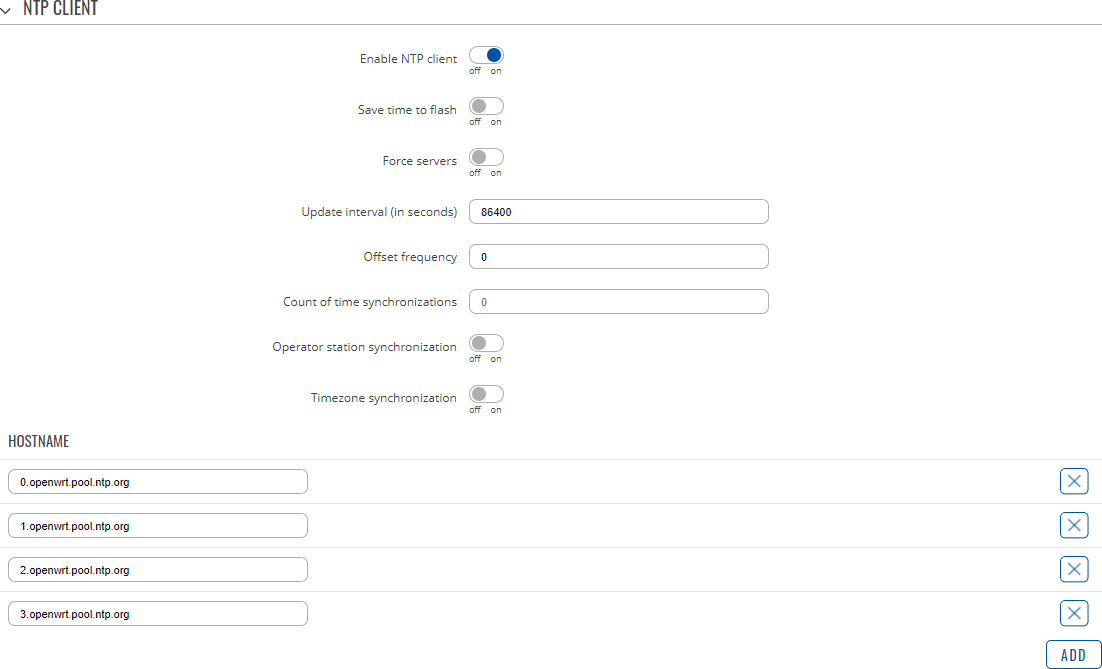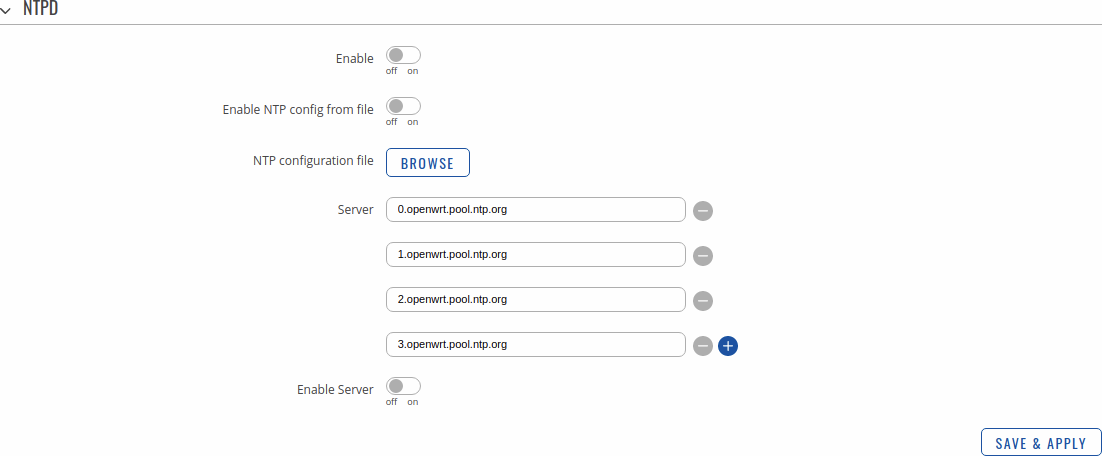RUT230 NTP: Difference between revisions
No edit summary |
Gytispieze (talk | contribs) No edit summary |
||
| (8 intermediate revisions by 3 users not shown) | |||
| Line 1: | Line 1: | ||
{{Template: Networking_rutos_manual_ntp | |||
<!------------------------DEVICE-----------------------> | |||
| name = RUT230 | |||
| series = RUT2 | |||
<!----------------------SEPARATORS---------------------> | |||
| gps = 0 | |||
| mobile = 1 | |||
}} | |||
= | |||
Latest revision as of 11:41, 6 October 2021
Main Page > EOL Products > RUT230 > RUT230 Manual > RUT230 WebUI > RUT230 Services section > RUT230 NTPThe information in this page is updated in accordance with firmware version RUT2_R_00.07.03.4.
Notice: This device has entered it's EOL (End of Life) cycle. For more information, visit our EOL policy here. Temporarily, some content in this page might not match features found in firmware listed above.
Note: click here for the old style WebUI (FW version RUT2XX_R_00.01.14.7 and earlier) user manual page.
Summary
Network Time Protocol (NTP) is a networking protocol for clock synchronization between computer systems over packet-switched, variable-latency data networks. This chapter is an overview of the NTP section for RUT230 devices.
General
The Time Synchronization section lets you select time zone and synchronize the time.
The figure below is an example of the Time Synchronization section and the table below provides information about the fields contained in that section:
| Field | Value | Description |
|---|---|---|
| Current system time | time; default: none | Current local time of the device. |
| Sync with browser | -(interactive button) | Click to synchronize device time and time zone to browsers, if your device time or time zone is not correct. |
| Time zone | time zone; default: UTC | The device will sync time in accordance with the selected time zone. |
NTP
This section is used to configure NTP client, server and time servers.
Time Synchronization
| Field | Value | Description |
|---|---|---|
| Enable NTP Client | off | on; default: on | Turns NTP on or off. |
| Save time to flash | off | on; default: off | Saves last synchronized time to flash memory. |
| Force Servers | off | on; default: off | Forces unreliable NTP servers. |
| Update interval (in seconds) | integer; default: 86400 | How often the device will update the time. |
| Offset frequency | integer; default: 0 | Adjusts the minor drift of the clock so that it will run more accurately. |
| Count of time synchronizations | integer; default: none | The amount of times the device will perform time synchronizations. Leave empty in order to set to infinite. |
| Operator Station Synchronization | off | on; default: off | Synchronizes time with mobile operator's base station. |
| Timezone Synchronization | off | on; default: off | Sync time data with mobile operator. |
| Hostname | ip | url; default: 0.openwrt.pool.ntp.org | NTP servers that this device uses to sync time. |
NTP Server
The device can also act as an NTP Server, providing clock synchronization to other devices in the network. From this section you can turn this feature on or off:
NTPD
The NTPD program is an operating system daemon that synchronizes the system clock to remote NTP time servers or local reference clocks. NTPD includes the ability to use this to keep your clock in sync and will run more accurately than a clock on a device not running NTPD. NTPD will also use several servers to improve accuracy. It is a complete implementation of NTP version 4 defined by RFC-5905, but also retains compatible with version 3 defined by RFC-1305 and versions 1 and 2, defined by RFC-1059 and RFC-1119, respectively.
| Field | Value | Description |
|---|---|---|
| Enable NTPD | off | on; default: off | Turns NTPD on or off. |
| Enable NTP config from file | off | on; default: off | Run NTPD with uploaded configuration file. |
| NTP configuration file | .conf file; default: none | Upload a custom configuration file. |
| Server | ip | url; default: 0.openwrt.pool.ntp.org | NTP servers that this device uses to sync time. |
| Enable Server | off | on; default: off | Enables NTPD server to make the router act as an NTP server so that it can provide time synchronization services for other network devices. |




